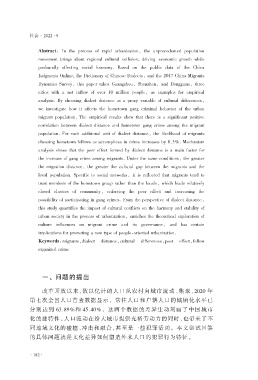Page 189 - 《社会》2022年第5期
P. 189
社会·2022·5
Abstract: In the process of rapid urbanization, the unprecedented population
movement brings about regional cultural collision, driving economic growth while
profoundly affecting social harmony. Based on the public data of the China
Judgments Online, the Dictionary of Chinese Dialects, and the 2017 China Migrants
Dynamics Survey, this paper takes Guangzhou, Shenzhen, and Dongguan, three
cities with a net inflow of over 10 million people, as examples for empirical
analysis. By choosing dialect distance as a proxy variable of cultural differences,
we investigate how it affects the hometown gang criminal behavior of the urban
migrant population. The empirical results show that there is a significant positive
correlation between dialect distance and hometown gang crime among the migrant
population. For each additional unit of dialect distance, the likelihood of migrants
choosing hometown fellows as accomplices in crime increases by 8.3%. Mechanism
analysis shows that the peer effect formed by dialect distance is a main factor for
the increase of gang crime among migrants. Under the same conditions, the greater
the migration distance, the greater the cultural gap between the migrants and the
local population. Specific to social networks, it is reflected that migrants tend to
trust members of the hometown group rather than the locals, which leads relatively
closed clusters of community, enforcing the peer effect and increasing the
possibility of participating in gang crimes. From the perspective of dialect distance,
this study quantifies the impact of cultural conflicts on the harmony and stability of
urban society in the process of urbanization, enriches the theoretical exploration of
culture influences on migrant crime and its governance, and has certain
implications for promoting a new type of people鄄oriented urbanization.
Keywords:migrants,dialect distance,cultural differences,peer effect,fellow
organized crime
一、 问题的提出
改革开放以来,数以亿计的人口从农村向城市流动、集聚,2020 年
第七次全国人口普查数据显示, 常住人口和户籍人口的城镇化水平已
分别达到 63.89%和 45.40%, 这两个数据的差异生动刻画了中国城市
化的独特性。 人口流动在给大城市提供充裕劳动力的同时,也带来了不
同地域文化的碰撞、冲击和融合,甚至是一些犯罪活动。 本文尝试回答
的具体问题就是文化差异如何塑造外来人口的犯罪行为特征。
· 182·

